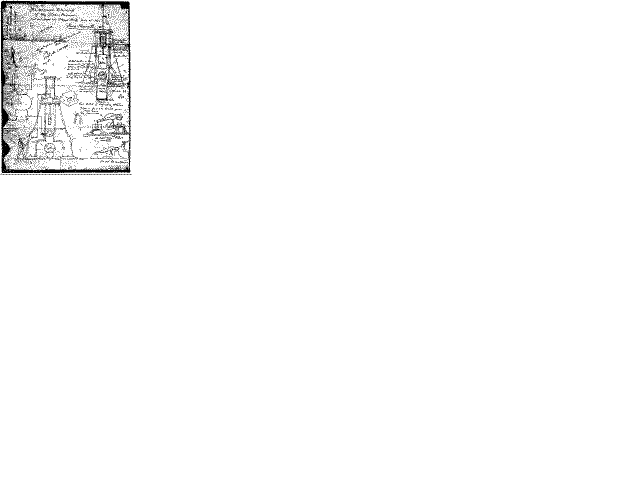This letter immediately set me a-thinking. How was it that the existing hammers were incapable of forging a wrought-iron shaft of thirty inches diameter? Simply because of their want of compass, of range and fall, as well as of their want of power of blow. A few moment's rapid thought satisfied me that it was by our rigidly adhering to the old traditional form of a smith's hand hammer -- of which the forge and tilt hammer, although driven by water or steam power, were merely enlarged modifications -- that the difficulty had arisen; as, whenever the largest forge hammer was tilted up to its full height, its range was so small that when a piece of work of considerable size was placed on the anvil, the hammer became "gagged;" so that, when the forging required the most powerful blow, it received next to no blow at all, as the clear space for the fall of the hammer was almost entirely occupied by the work on the anvil.
The obvious remedy was to contrive some method by which a ponderous block of iron should be lifted to a sufficient height above the object on which it was desired to strike a blow, and then to let the block full down upon the forging, guiding it in its descent by such simple means as should give the required precision in the percussive action of the falling mass following up this idea, I got out my "Scheme Book," on the pages of which I generally thought out, with the aid of pen and pencil, such mechanical adaptations as I had conceived in my mind, and was thereby enabled to render them visible. I then rapidly sketched out my Steam Hammer, having it all clearly before me in my mind's eye. In little more than half an hour after receiving Mr. Humphries' letter narrating his unlooked-for difficulty, I had the whole contrivance in all its executant details, before me in a page of my Scheme Book, a reduced photographed copy of which I append to this description. The date of this first drawing was the 24th November, 1839.
 First drawing of steam hammer, 24th Nov. 1839
First drawing of steam hammer, 24th Nov. 1839
My Steam Hammer as thus first sketched, consisted of, first, a massive anvil on which to rest the work; second, a block of iron constituting the hammer or blow-giving portion; and, third, an inverted steam cylinder to whose piston-rod the hammer-block was attached. All that was then required to produce a most effective hammer was simply to admit steam of sufficient pressure into the cylinder, so as to act on the under- side of the piston, and thus to raise the hammer-block attached to the end of the piston rod. By a very simple arrangement of a slide valve, under the control of all attendant, the steam was allowed to escape and thus permit the massive block of iron rapidly to descend by its own gravity upon the work then upon the anvil.
Thus, by the more or less rapid manner in which the attendant allowed the steam to enter or escape from the cylinder, any required number or any intensity of blows could be delivered. Their succession might be modified in an instant. The hammer might be arrested and suspended according to the requirements of the work. The workman might thus, as it were, think in blows. He might deal them out on to the ponderous glowing mass, and mould or knead it into the desired form as if it were a lump of clay; or pat it with gentle taps according to his will, or at the desire of the forgeman.
Rude and rapidly sketched out as it was, this, my first delineation of the steam hammer, will be found to comprise all the essential elements of the invention. Every detail of the drawing retains to this day the form and arrangement which I gave to it forty-three years ago. I believed that the steam hammer would prove practically successful; and I looked forward to its general employment in the forging of heavy masses of iron. It is no small gratification to me now, when I look over my rude and hasty first sketch, to find that I hit the mark so exactly, not only in the general structure but in the details; and that the invention as I then conceived it and put it into shape, still retains its form and arrangements intact in the thousands of steam hammers that are now doing good service in the mechanical arts throughout the civilised world.
But to return to my correspondence with the Great Western Steamship Company. I wrote at once to Mr. Humphries, and sent him a sketch of my proposed steam hammer. I told him that I felt assured he would now be able to overcome his difficulty, and that the paddle-shaft of the Great Britain might now be forged. Mr. Humphries was delighted with my design. He submitted it to Mr. Brunel, engineer- in-chief of the steamship: to Mr. Guppy, the managing director; and to other persons interested in the
| Previous chapter/page | Back | Home | Email this | Search | Discuss | Bookmark | Next chapter/page |